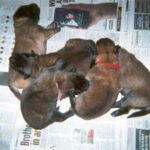The method we use is Dr. Dunbar’s bite inhibition training. It is a humane way to teach your pup not to bite. There is no yelling and no hitting. No other forms of punishment that would hurt the dog psychologically or physically.
The best time to start is the day you bring your puppy home. Know that all puppies bite or “mouth”. This is a natural occurrence when they are still with their mom and littermates. It’s their form of playing. When the puppy is taken away from its mom and littermates, you become the object of his play.
Dr. Dunbar’s inhibition training starts with playing with your puppy. When the puppy bites or mouths you too hard, make a shrill high-pitched yelp. (This is what a littermate would do.) If the puppy stops mouthing you when you yelp, praise him, pet him and continue playing with him.
If the puppy does not stop when you yelp, immediately stop playing with him and walk away. This is hard to do. You may find that having the puppy tethered or having him in a confined place will allow you to walk away from him without any more interaction. Remember even negative attention is attention in this case.
Dr. Dunbar says that 90% of puppies will stop biting/mouthing when a person yelps, usually in mid-bite. However, the 10% that doesn’t stop may well escalate their bad behavior. You should immediately confine the puppy or stop playing with it.
Gradually Dr. Dunbar suggests that you start limiting how hard your puppy is biting/mouthing you. If your puppy exceeds that limit, let out a yelp.
Over time, keep setting limits to a softer and softer bite/mouth. Do not rush this. Take your time with the puppy so he really understands what you are training him to do.
Some tips for a successful outcome using Dr. Dunbar’s method of biting/mouthing inhibition training are as follows.
Always try to work with the pup when he is calm. And try to never let the puppy initiate your “play” time; that is for you to start with your puppy.
Until your puppy starts to understand what you want him to do, it is a great idea to have a lot of chew toys around. Let him chew on these instead of you until you are ready to work with him.
At this point, you may wonder how this bite/mouth inhibition works in the real world. Here is an example.
Suppose your dog is lying peacefully and a small child jumps on him, and maybe even pulls an ear or pokes an eye. The dog, no matter how well-behaved normally, will have the normal response to bite. If this occurs, the dog that has been taught bite/mouth inhibition will mouth the child, but not sink his teeth in, thereby, preventing serious injury.
Do you see how gradually teaching the puppy to bite/mouth softer and softer comes in to play? Do you see how giving high-pitched yelps when the puppy mouths too hard simulates a child or an adult being bitten and crying out?
When dogs bite out of fear, or out of self-preservation, they are usually blamed for the incident, no matter whose fault it was.
This training method of biting/mouthing inhibition is not only a great way to protect others from being seriously bitten; it is also a way to protect your dog from serious consequences of biting. Biting/mouthing inhibition training takes time and effort on your part. But you can help to insure a safe and happy life for your dog and those around it. Try it and be amazed.
This method is Dr. Dunbar’s. His books on dogs can be found on the Internet and libraries.




